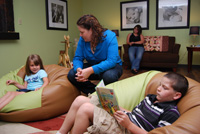Editorial
Front Page - Friday, August 27, 2010
Hatch’s House of Hope healing hearts, minds of young cancer patients
David Laprad
 Hatch’s House of Hope is a landmark pediatric cancer care center. Located in the Erlanger Medical Plaza, the center offers psychological, emotional and educational support to young cancer patients and their family.
- David Laprad
Hatch’s House of Hope is a landmark pediatric cancer care center. Located in the Erlanger Medical Plaza, the center offers psychological, emotional and educational support to young cancer patients and their family.
- David Laprad
Cancer is the leading cause of death by disease among U.S. children up to age 15. In 2009 alone, the National Cancer Institute was expecting approximately 10,730 new cases of pediatric cancer. But there is good news: Although the incidence of cancer in children has increased somewhat over the past 30 years, mortality rates have declined by more than 50 percent for many childhood cancers, according to the Institute. In addition, the combined five-year survival rate for all childhood cancers has improved from less than 50 percent before the ‘70s to 80 percent today.
The treatments behind these numbers offer a chance for survival to a young cancer patient. Cancer damages more than the body, though; it also affects the spirit. When this happens, it can be hard to believe in happy endings.
Hatch’s House of Hope in Chattanooga, a landmark pediatric cancer care center, goes into the places medicine cannot reach to restore a child’s spirit. Dr. Erica Skidmore, chief psychologist at the center, explains:
“We offer psychological, emotional and educational support. We want to equip and empower children and their entire family unit to be able to thrive in the face of pediatric cancer, not just survive.
“The survival rates for pediatric cancer are steadily increasing, which is wonderful, but the treatments kill healthy cells. That can change how a child’s brain functions, and affect working memory and processing speed. That’s where we come in.”
Hatch’s aims to improve a child’s mental processes through academic coaching and cognitive rehabilitation. The latter includes simple computer exercises that can develop brain function, similar to how a person gains muscle mass by working out.
Cancer can also do devastating emotional damage, which Hatch’s tackles through individual, marital and family therapy.
“Once a child is cancer free, he still has to deal with a potential lifetime of after effects. Maybe he was a straight ‘A’ student and an athlete, but then he had bone cancer. So, he’s had an amputation and can’t play sports anymore, and he doesn’t have the emotional support of his team. Not only that, but he’s struggling in school because he can’t remember things the way he used to,” Skidmore says.
“So, he’s doing poorly in school and he can’t connect with his friends, so he starts displaying behavioral problems because of the emotions he’s experiencing. We like to step in and put out that fire before it spreads.”
The different treatments at Hatch’s include art therapy, music therapy and diversionary therapy, that latter of which might be as simple as a day at the racetrack with mom and dad to create positive memories.
Since cancer affects each child differently, Hatch’s tailors its services to meet each individual’s unique needs.
Before therapy begins, Skidmore meets with the members of a family to get a feel for the kinds of issues everyone is facing, then does a baseline assessment on the cancer patient using “standardized neurocognitive measures.” This gives her objective data on the child, which she presents to a panel of educators, therapists, social workers and pediatricians. The end result of their analysis is an Individual Intervention Plan for each member of the family.
“We help not only the affected child but also the siblings. In a lot of cases, mom and dad’s attention is focused on the affected child, and meanwhile, the siblings are falling behind in school and having behavioral problems,” Skidmore says.
Hatch’s provides all of its services free of charge. To fund its operations, the organization relies on donations, grants and partnerships. While it isn’t easy raising money in economically challenging times, Skidmore likes the freedom working for a nonprofit gives her.
“In private practice, the patient’s insurance company limits what you can do. You might get only eight sessions with a patient, or you might want to refer a family to art therapy, but insurance won’t pay for that.
“Here, I don’t have those limitations. I’m able to spend as much time as I want with each individual. I’m able to get to know them and what they need, and I can offer them a wide variety of services. That allows me to give them the best treatment possible.”
Hatch’s House of Hope is an arm of the Austin Hatcher Foundation for Pediatric Cancer. The Foundation was formed in 2006 by Amy Jo and Jim Osborn, who’s son, Austin Hatcher, was diagnosed with an untreatable form of cancer when he was two months old. He passed away 11 days later.
Today, Hatch’s is one year old. While it’s still the only one of its kind, the Foundation is in talks with other cancer centers around the country about opening additional Houses of Hope. The Osborn’s vision is that every pediatric cancer center in the country will someday have a place that can heal the places medicine cannot reach.
To learn more, visit www.hatchshouse.org.
|
|